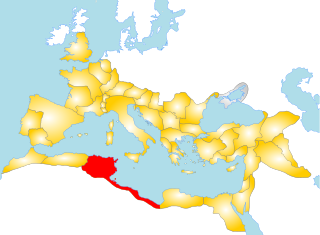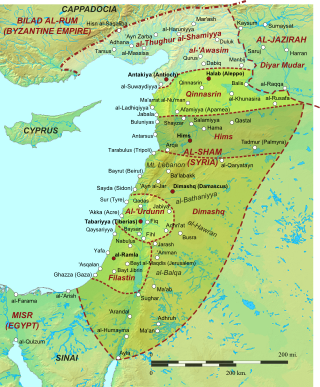
Medieval Muslim Algeria was a period of Muslim dominance in Algeria during the Middle Ages, spanning the millennium from the 7th century to the 17th century. The new faith, in its various forms, would penetrate nearly all segments of society, bringing with it armies, learned men, and fervent mystics; in large part, it would replace tribal practices and loyalties with new social norms and political idioms.

Ifriqiya, also known as al-Maghrib al-Adna, was a medieval historical region comprising today's Tunisia and eastern Algeria, and Tripolitania. It included all of what had previously been the Byzantine province of Africa Proconsularis and extended beyond it, but did not include the Mauretanias.

Tripolitania, historically known as the Tripoli region, is a historic region and former province of Libya.

Abū Muḥammad ʿAbd Allāh ibn al-Ḥusayn, better known by his regnal name al-Mahdī biʾllāh, was the founder of the Isma'ili Fatimid Caliphate, the only major Shi'a caliphate in Islamic history, and the eleventh Imam of the Isma'ili branch of Shi'ism.

Jund Filasṭīn was one of the military districts of the Umayyad and Abbasid province of Bilad al-Sham (Levant), organized soon after the Muslim conquest of the Levant in the 630s. Jund Filastin, which encompassed most of Palaestina Prima and Palaestina Tertia, included the newly established city of Ramla as its capital and eleven administrative districts (kura), each ruled from a central town.

The history of North Africa has been divided into its prehistory, its classical period, the arrival and spread of Islam, the colonial period, and finally the post-independence era, in which the current nations were formed. The region has been influenced by many diverse cultures. The development of sea travel firmly brought the region into the Mediterranean world, especially during the classical period. In the 1st millennium AD, the Sahara became an equally important area for trade as camel caravans brought goods and people from the south of the Sahara. The region also has a small but crucial land link to the Middle East, and that area has also played a key role in the history of North Africa.

The Exarchate of Africa was a division of the Byzantine Empire around Carthage that encompassed its possessions on the Western Mediterranean. Ruled by an exarch (viceroy), it was established by the Emperor Maurice in 591 and survived until the Muslim conquest of the Maghreb in the late 7th century. It was, along with the Exarchate of Ravenna, one of two exarchates established following the western reconquests under Emperor Justinian I to administer the territories more effectively.

Abū al-Qāsim Muḥammad ibn ʿAbd Allāh, better known by his regnal name al-Qāʾim (القائم) or al-Qāʾim bi-Amr Allāh, was the second caliph of the Fatimid dynasty, ruling in Ifriqiya from 934 to 946. He was the twelfth Isma'ili Imam, succeeding his father Abd Allah al-Mahdi Billah.

ʿUqba ibn Nāfiʿ ibn ʿAbd al-Qays al-Fihrī al-Qurashī, also simply known as Uqba ibn Nafi, was an Arab general serving the Rashidun Caliphate since the reign of Umar and later the Umayyad Caliphate during the reigns of Mu'awiya I and Yazid I, leading the Muslim conquest of the Maghreb, including present-day Libya, Tunisia, Algeria and Morocco. He is credited with establishing Umayyad rule in North Africa. Uqba was the nephew of Amr ibn al-As. He is often surnamed al-Fihri in reference to the Banu Fihr, a clan connected to the Quraysh. His descendants would be known as the ʿUqbids or Fihrids.

The conquest of the Maghreb by the Rashidun and Umayyad Caliphates commenced in 647 and concluded in 709, when the Byzantine Empire lost its last remaining strongholds to Caliph Al-Walid I. The North African campaigns were part of the century of rapid early Muslim conquests.
The Berbers are an indigenous ethnic group of the Maghreb region of North Africa. Following the Muslim conquest of the Maghreb, most Berber tribes eventually became Muslims. Presently, about one-sixth of the population of Maghreb speaks one of the Berber languages, but most of them also speak some form of Arabic. Berbers are the first non-Arab people to have established an Islamic state.
Hassan ibn al-Nu'man al-Ghassani was an Arab general of the Umayyad Caliphate who led the final Muslim conquest of Ifriqiya, firmly establishing Islamic rule in the region. Appointed by Caliph Abd al-Malik, Hassan launched a series of campaigns during the closing years of the 7th century, during which he defeated the Byzantines and the Berbers led by al-Kahina. The Byzantine capital of Carthage was destroyed in 698 and the nearby city of Tunis was founded in the following year. In Kairouan, Hassan set up a Muslim administration for the province to collect taxes from its Christian inhabitants and pay the troops. He enrolled thousands of Berbers into the army, which proved critical to later Muslim military successes in the Maghreb and the Iberian Peninsula. He was ultimately ousted from his post by the governor of Egypt, Abd al-Aziz ibn Marwan, due to a power struggle for influence over Ifriqiya.

The History of early Islamic Tunisia opens with the arrival of the Arabs who brought their language and the religion of Islam, and its calendar. The Arab conquest followed strategy designed by the Umayyad Caliphate regarding its long-term conflict with the Byzantine Empire. The native Berbers eventually converted to Islam. They might have seen some similarities between themselves and the Arabs, in similar cognate culture, such as familiarity with a pastoral way of life. The first local Islamic ruling house, the Aghlabids, consisted primarily of rule by leading members of this Arab tribe. Fundamental elements of Islamic civilization were established. Although accepting Islam, many Berbers nonetheless resisted rule by the Arabs, establishing the Rustamid kingdom following the Kharijite revolt. Next in Ifriqiya (Tunisia) arose the Shia Fatimids, inspired by a few immigrants from the east yet consisting for the most part of Ifriqiya Berbers. The Fatimids later expanded their rule east, through conquest by Berber armies of Egypt, and established their caliphate there which came to include Syria and the Hejaz.

The Caliphate of Córdoba, also known as the Córdoban Caliphate, was an Arab Islamic state ruled by the Umayyad dynasty from 929 to 1031. Its territory comprised Iberia and parts of North Africa, with its capital in Córdoba. It succeeded the Emirate of Córdoba upon the self-proclamation of Umayyad emir Abd ar-Rahman III as caliph in January 929. The period was characterized by an expansion of trade and culture, and saw the construction of masterpieces of al-Andalus architecture.
Abū'l-Futūh Barjawān al-Ustādh was a eunuch palace official who became the prime minister (wāsiṭa) and de facto regent of the Shia Fatimid Caliphate in October 997, and held the position until his assassination. Of obscure origin, Barjawan became the tutor of heir-apparent al-Hakim bi-Amr Allah, who became caliph in 996 with the death of al-Aziz Billah. On al-Hakim's coronation, power was seized by the Kutama Berbers, who tried to monopolize government and clashed with their rivals, the Turkic slave-soldiers. Allied with disaffected Berber leaders, Barjawan was able to seize the reins of government for himself in 997. His tenure was marked by a successful balancing act between the Berbers and the Turks, as well as the rise of men of diverse backgrounds, promoted under his patronage. Militarily, Barjawan was successful in restoring order to the Fatimids' restive Levantine and Libyan provinces, and set the stage for an enduring truce with the Byzantine Empire. The concentration of power in his hands and his overbearing attitude alienated al-Hakim, however, who ordered him assassinated and thereafter assumed the governance of the caliphate himself.
The Battle of Sufetula took place in 647 between the Arab Muslim forces of the Rashidun Caliphate and the Byzantine Exarchate of Africa.
The first Fatimid invasion of Egypt occurred in 914–915, soon after the establishment of the Fatimid Caliphate in Ifriqiya in 909. The Fatimids launched an expedition east, against the Abbasid Caliphate, under the Berber General Habasa ibn Yusuf. Habasa succeeded in subduing the cities on the Libyan coast between Ifriqiya and Egypt, and captured Alexandria. The Fatimid heir-apparent, al-Qa'im bi-Amr Allah, then arrived to take over the campaign. Attempts to conquer the Egyptian capital, Fustat, were beaten back by the Abbasid troops in the province. A risky affair even at the outset, the arrival of Abbasid reinforcements from Syria and Iraq under Mu'nis al-Muzaffar doomed the invasion to failure, and al-Qa'im and the remnants of his army abandoned Alexandria and returned to Ifriqiya in May 915. The failure did not prevent the Fatimids from launching another unsuccessful attempt to capture Egypt four years later. It was not until 969 that the Fatimids conquered Egypt and made it the centre of their empire.
Zuhayr ibn Qays al-Balawī was a companion of the Islamic prophet Muhammad and an Arab commander who fought in the service of the Rashidun, Umayyad and Zubayrid caliphs. He played a key role in the early Muslim conquests of Egypt, Barqa (Cyrenaica) and Ifriqiya. When the latter province fell to a Byzantine–Berber alliance in 682, Zuhayr was given command of the army to restore Arab rule. During that campaign, he temporarily retook Kairouan, the Arabs' capital in Ifriqiya, and killed the Berber chief Kasila, but was slain by Byzantine raiders on his way back to Barqa.
Ahmad ibn Ziyadat Allah ibn Qurhub, commonly known simply as Ibn Qurhub, ruled Sicily in rebellion against the Fatimid Caliphate, from 913 to 916. He launched raids against the Byzantine Empire in southern Italy and against the shores of Fatimid Ifriqiya, but was deposed and handed over to the Fatimids, who executed him and his followers in July 916.

The Arab migrations to the Maghreb involved successive waves of migration and settlement by Arab people in the Maghreb region of North Africa, encompassing modern-day Algeria, Libya, Morocco and Tunisia. The process took place over several centuries, lasting from the early 7th century to the 17th century. The Arab migrants hailed from the Middle East, particularly the Arabian Peninsula, with later groups arriving from the Levant and Iraq.















